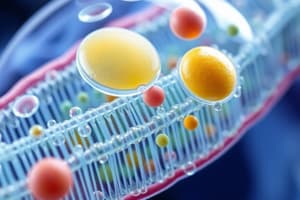Podcast
Questions and Answers
What is the primary structural component of the cell membrane?
What is the primary structural component of the cell membrane?
- Proteins
- Phospholipids (correct)
- Carbohydrates
- Nucleic acids
What does the term 'semipermeable' in relation to cell membranes mean?
What does the term 'semipermeable' in relation to cell membranes mean?
- Only certain substances can pass through (correct)
- All substances can freely pass through
- Substances can pass through only when facilitated
- No substances can pass through
What happens to a cell placed in a hypertonic solution?
What happens to a cell placed in a hypertonic solution?
- It will swell and burst
- It will maintain its size
- It will shrivel as water is drawn out (correct)
- It will remain unaffected by the solution
How do the phosphate heads in the phospholipid bilayer orient themselves?
How do the phosphate heads in the phospholipid bilayer orient themselves?
What type of solution causes a cell to swell and possibly burst?
What type of solution causes a cell to swell and possibly burst?
In the context of diffusion, what does 'high concentration' refer to?
In the context of diffusion, what does 'high concentration' refer to?
What best describes facilitated diffusion?
What best describes facilitated diffusion?
Which term refers to the balance of solutes inside and outside a cell?
Which term refers to the balance of solutes inside and outside a cell?
What characteristic of the lipid tails in the phospholipid bilayer is notable?
What characteristic of the lipid tails in the phospholipid bilayer is notable?
Which process specifically involves the movement of water across a semipermeable membrane?
Which process specifically involves the movement of water across a semipermeable membrane?
Flashcards
Phospholipid Bilayer
Phospholipid Bilayer
The cell membrane’s primary structure, composed of two layers of phospholipids arranged with their hydrophilic heads facing outwards and their hydrophobic tails facing inwards.
Phosphate Heads
Phosphate Heads
The heads of phospholipids are attracted to water due to their polar nature.
Lipid Tails
Lipid Tails
The tails of phospholipids are repelled by water due to their nonpolar nature.
Fluid Mosaic Model
Fluid Mosaic Model
Signup and view all the flashcards
Semipermeable Membrane
Semipermeable Membrane
Signup and view all the flashcards
Diffusion
Diffusion
Signup and view all the flashcards
Osmosis
Osmosis
Signup and view all the flashcards
Hypertonic Solution
Hypertonic Solution
Signup and view all the flashcards
Hypotonic Solution
Hypotonic Solution
Signup and view all the flashcards
Isotonic Solution
Isotonic Solution
Signup and view all the flashcards
Study Notes
Cell Membrane Structure and Function
- The cell membrane is composed of lipids and proteins, separating the cell's contents from the outside world.
- It's a bilayer, meaning it consists of two layers of phospholipids.
- Phospholipids have hydrophilic (water-loving) heads and hydrophobic (water-fearing) tails.
- The heads face the watery environment, while the tails face away from it, forming a barrier.
- The Fluid Mosaic Model more accurately depicts the structure of the cell membrane.
- It's called "fluid" because the cell membrane isn't rigid, and "mosaic" because of the various proteins embedded in the lipid bilayer.
- Proteins within the membrane can help with transport.
Membrane Transport
- Semipermeable: The cell membrane allows some substances to pass through while blocking others.
- Diffusion: The movement of liquid or gas molecules from a high concentration area to a low concentration area, across a semipermeable membrane.
- Osmosis: The diffusion of water across a semipermeable membrane, influenced by solute concentrations.
- Hypertonic solution: A solution with a higher solute concentration outside the cell than inside. Water moves out of the cell, causing it to shrink.
- Hypotonic solution: A solution with a lower solute concentration outside the cell than inside. Water moves into the cell, causing it to swell and potentially burst.
- Isotonic solution: A solution with an equal solute concentration inside and outside the cell. Water moves in and out of the cell at an equal rate, maintaining the cell's shape.
Types of Membrane Transport
- Facilitated Diffusion: Movement of molecules across the membrane with the help of carrier proteins, without energy input.
- Active Transport: Movement of molecules against the concentration gradient, requiring energy (like ATP).
- Bulk Transport: Large molecules are moved across the membrane.
- Exocytosis: Substances are released out of the cell.
- Endocytosis: Substances are taken into the cell.
- Receptor-mediated endocytosis: A specific type of endocytosis where molecules bind to specific receptors on the cell surface before being taken into the cell.
Studying That Suits You
Use AI to generate personalized quizzes and flashcards to suit your learning preferences.



